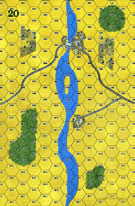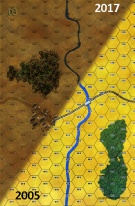|
Zaritschanka: Seizing the Bridgehead Fronte Russo #2 |
||
|---|---|---|
|
(Attacker)
Germany
(Attacker) Italy |
vs | Soviet Union (Defender) |
| Formations Involved | ||
|---|---|---|
| Germany |  |
76th Infantry Division |
| Germany |  |
Abraham Group |
| Italy |  |
79º Reggimento Fanteria "Roma" |
| Soviet Union |  |
273rd Rifle Division |

|
| Overall Rating, 4 votes |
|---|
|
4
|
| Scenario Rank: --- of 957 |
| Parent Game | Fronte Russo |
|---|---|
| Historicity | Historical |
| Date | 1941-09-23 |
| Start Time | 06:00 |
| Turn Count | 20 |
| Visibility | Day |
| Counters | 83 |
| Net Morale | 0 |
| Net Initiative | 2 |
| Maps | 6: 1, 2, 20, 3, 4, 8 |
| Layout Dimensions | 86 x 84 cm 34 x 33 in |
| Play Bounty | 152 |
| AAR Bounty | 166 |
| Total Plays | 4 |
| Total AARs | 1 |
| Battle Types |
|---|
| Inflict Enemy Casualties |
| River Crossing |
| Surprise Attack |
| Urban Assault |
| Conditions |
|---|
| Off-board Artillery |
| Randomly-drawn Aircraft |
| Reinforcements |
| Terrain Mods |
| Joint Forces Battle |
| Scenario Requirements & Playability | |
|---|---|
| Eastern Front | Maps + Counters |
| Fronte Russo | Base Game |
| Road to Berlin | Maps |
| Introduction |
|---|
|
The Pasubio Division deployed along the Orely River on September 18th. Its front extended from the river's confluence with the Dneper to the town of Voinovka, shielding the right flank of the German 17th Army. After the reduction of the Kiev pocket, a new effort to encircle the Soviets could begin. This time, the Soviet 6th Army would fall into the trap. This reconstructed formation was facing the SS Viking division at Dnepropetrovsk and holding the middle segment of the Dneper line. The Italian 79th Regiment and a German battle group were given the task of capturing a bridgehead near the town of Zaritschanka. Thearea they secured had to be large enough to prevent the Soviets from spotting the German engineers engaged in building a new bridge next to the old destroyed one. In theearly hours of September 23rd, after silently crossing the river, Axis forces attacked. |
| Conclusion |
|---|
|
The Soviet forces were concentrated in the local villages, and the attack caught them by surprise. Battle raged into the fields, which hindered visibility to a large extent. Despite the intervention of Soviet artillery and aircraft, the initial part of the Italian attack went well. By noon the Soviets had withdrawn toward the east-northeast, and Axis forces had conquered the village of Jarisovka, directly facing the bridge. |
| 3 Errata Items | |
|---|---|

|
The reduced direct fire value of the Heer HMG became 5-5 starting with Fall of France. (plloyd1010
on 2015 Jul 31)
|

|
The morale and combat modifiers of German Sergeant #1614 should be "0", not "8". (Shad
on 2010 Dec 15)
|

|
The reduced direct fire value in Kursk: Burning Tigers is 4-4. (plloyd1010
on 2015 Jul 31)
|
| Combates por Zaritschanka: toma de la cabeza de puente | ||||||||||||
|---|---|---|---|---|---|---|---|---|---|---|---|---|
En este escenario una fuerza ítaloalemana debe tomar una cabeza de puente en el río Orely, cerca de la población de Zaritschanka. El área de la cabeza de puente debe ser lo bastante grande para evitar que los observadores de artillería soviéticos puedan ver la construcción de un puente por ingenieros alemanes. La fuerza italiana está compuesta por tres compañías de infantería, tres secciones de morteros y tres baterías de artillería (65/17). Los alemanes ("grupo Abraham") disponen también de tres compañías de artillería y dos secciones de morteros. Ambos aliados cuentan con un contundente apoyo de artillería fuera del mapa (3 x 16 y 1 x 24 los alemanes y 2 x 8 y 2 x 14 los italianos). Por su parte los soviéticos cuentan con un batallón y medio de infantería y tres secciones de morteros. Además, a partir del turno ocho entra como refuerzo una compañía de infantería y una sección de cañones AT de 45mm. También disponen de apoyo artillero fuera del mapa (3 x 10, 1 x 16) y de apoyo aéreo. El objetivo de las fuerzas del Eje es limpiar de enemigos el mapa 3 sin tener más de 12 steps de bajas. En otro caso los soviéticos ganan la partida. El plan del Eje es, para los alemanes, atacar la población del mapa 3 y desalojarla de enemigos. Al mismo tiempo los italianos deben atacar la ciudad del mapa 1, expulsar a la guarnición soviética e impedir que los refuerzos soviéticos ataquen a las fuerzas del Eje por la retaguardia. Los soviéticos, por su parte, deben resistir a toda costa en la población del mapa 3 y mantener limpia de enemigos la parte norte de los mapas 3 y 4, de manera que puedan enviar refuerzos a la población del mapa 3 y mantener así alimentado el combate. Los del Eje llevan la iniciativa y atacan de acuerdo al plan trazado. Sin embargo, los italianos cometen un grave error inicial, ya que despliegan las tres baterías de artillería de 65/17 en el mismo hex, buscando la concentración de fuego. Los soviétics observan inmediatamente esta disposición y bombardean los emplazamientos italianos con artillería y luego los atacan con aviones. Al final, las tres baterías italianas son tontamente aniquiladas. El ataque sigue el plan fijado. Las fuerzas del Eje, lentamente, van desalojando al enemigo de las poblaciones de los mapas 1 y 3. Los soviéticos se defienden encarnizadamente y su artillería y el fuego de oportunidad de la infantería aniquila varios steps enemigos. En el turno 10 varios disparos afortunados de los soviéticos eliminan varias unidades enemigas más, con lo que las fuerzas del Eje alcanzan la pérdida fatídica del 13º step y pierden la partida. Magnífico escenario. La pronta terminación de la partida no significa que la victoria soviética haya sido fácil. La mala disposición de las baterías de artillería italiana y los disparos afortunados de los soviéticos han desnivelado la balanza en su favor demasiado pronto. El escenario está bien pensado, me parece bastante realista y obliga a desarrollar una táctica bien elaborada a cada bando. |
||||||||||||
| 0 Comments |

 FrRu001
FrRu001 





























